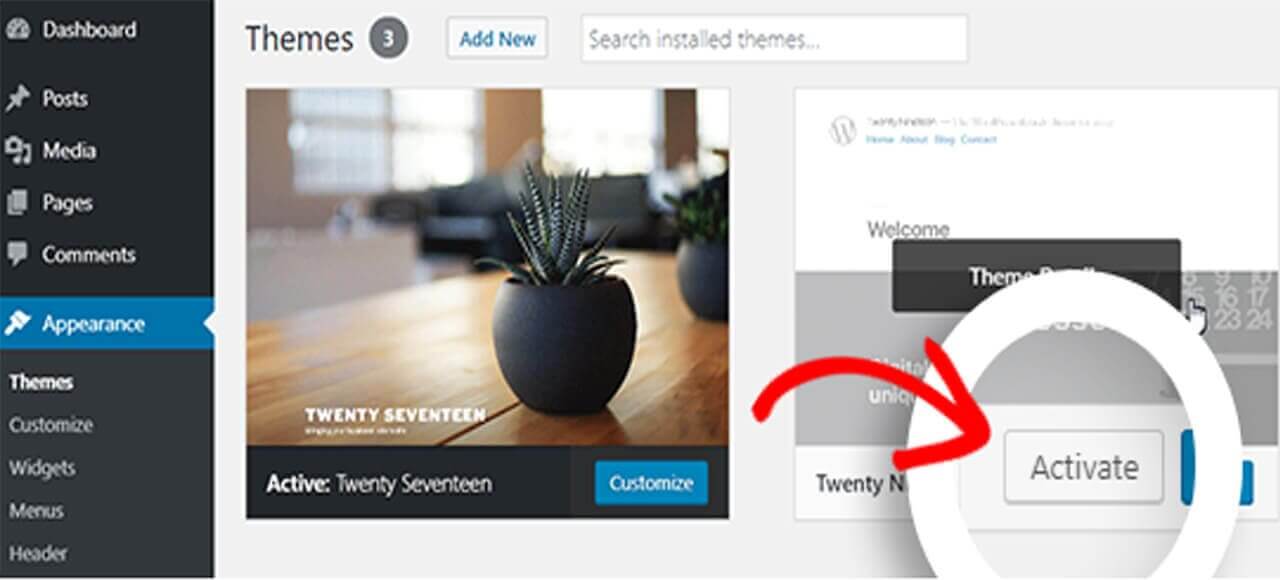What should you thing and do before switching WordPress themes? In this detail guide I will discuss 13 things to do before switching WordPress theme.
There are some crucial procedures you need to follow when changing your WordPress theme to form sure everything goes well which no crucial information is lost.
We’ll outline the key actions you ought to do before switching WordPress themes in our WordPress checklist.
Every website owner must make a major choice a minimum of once every few years, which is whether or not to vary their theme.
Of course, you wish to work out your motivation for switching and choose an issue that meets all of your requirements.
If you’re seeking for suggestions, take a look at our lists of the most effective WordPress blog themes and top WordPress multi-purpose themes.
Checklist before switching WordPress theme
Following the subsequent checklist will facilitate your avoid losing any content or data after you’ve selected the new theme and are able to make the transfer.
So, check these steps carefully to keep your site as it is before switching WordPress theme.
1. Make a note of any modifications made to WordPress theme
Some WordPress website owners may directly add code snippets to their theme files to personalize their WordPress themes. You should check that before switching WordPress theme.
Code snippets is also a terrific method to feature to your website additional features that are not included within the default theme.
However, it’d be simple to lose track of such snippets if you add them straight to your theme files.
Make sure you bear your existing theme files and make a note of all the additional code that has been included if you or an internet developer performed these modifications.
We always advise employing a site-specific plugin or a code snippets plugin for adding code snippets within the future.
This way, whether or not your theme changes later, you’ll still use those snippets. See our beginner’s guide copying online page into WordPress for more information.
2. Get Up-to-Date Performance Statistics
You should evaluate the performance and loading time of your present website before changing the theme. this allows you to match any variations within the page load speed after changing themes.
You need to form sure the new theme is quicker than the one you’re currently using since WordPress speed and performance are crucial to user experience and WordPress SEO.
Using a WordPress speed testing tool, like the free website speed testing tool from IsItWP, you’ll be able to quickly verify your existing website performance metrics.
3. Note the Sidebars and Widget Areas
Use sidebars to feature various widgets to your website, like popular articles widgets, social networking buttons, and email newsletter signup forms. You should take a not before switching WordPress theme.
If you turn themes, your widgets can suddenly relocate or vanish from your site since every theme features a distinct set of widget regions.
For this reason, before switching themes, it’s crucial to stay track of the widgets you’re utilizing in your WordPress sidebars and the other widgetized portions of your website. After switching, you’ll simply recreate them.
Make careful to repeat any custom code or shortcodes you’ve made and store them in a very secure location so you’ll use them together with your new theme.
4. WordPress tracking codes should be copied
A lot of individuals will directly include analytics tracking code in their theme files. you will also add tracking codes straight to your theme settings panel with certain WordPress themes.
The frequent error is to ignore these crucial tracking numbers. Make sure to repeat all of the tracking codes from your current website that you just use for analytics, advertising, and other purposes so you’ll apply them to your new website.
We advise utilizing a plugin like MonsterInsights to put in Google Analytics in WordPress if you would like to form life simple for yourself.
You can depend upon MonsterInsights to make sure that your analytics won’t be interrupted or data lost.
Additionally, you’ll need access to supplementary tracking features like author tracking, link and button click tracking, WordPress category and tag analytics, and far more.
So, don’t forget to copy WordPress tracking code before switching WordPress theme.
5. Your current WordPress website should be protected
Regularly backing up your website is sometimes a wise idea. you must make a radical backup of your posts, pages, plugins, media, and databases before changing your theme.
Using a WordPress backup plugin to create a backup of your complete site is that the simplest method to try to to this. See our tutorial on using UpdraftPlus to backup your WordPress website for more information.
This will ensure that if anything goes wrong while switching themes, you’ll be able to quickly restore your website.
6. Turn on maintenance mode for your WordPress website
It’s usually an honest idea to place your website into maintenance mode while making updates to that. you’ll provide your visitors a helpful message while your site is in maintenance mode.
This helps stop users from seeing your website while it’s still under development or only partially done.
We advise utilizing the SeedProd plugin to try to to this. Over 1 million websites utilize the best drag and drop WordPress page builder.
It enables you to quickly design personalized 404 pages, coming soon pages, landing sites, and maintenance mode pages.
7. Check all installed WordPress plugins functionality
Checking the installed plugins is must before switching WordPress theme.
Make sure you’ve got the identical functionality as before which all of your previous plugins operate along with your new theme after you’ve activated a brand new WordPress theme.
The code snippets that you simply copied from your previous WordPress theme files could also be reinserted first. See our beginner’s orient copying code snippets into WordPress for more information.
Use your site’s features that are driven by WordPress plugins for a long time then. See our beginner’s guide to troubleshooting WordPress issues if you’re currently seeing any difficulties.
8. Test the new WordPress theme on different devices and browsers
You can make sure that your new website appears excellent across a spread of browsers, screen sizes, operating systems, and mobile devices by doing cross-browser testing.
The majority of individuals who visit your WordPress site will presumably do so using Google Chrome. However, many scores of people throughout the world still use alternative web browsers like Firefox, Microsoft Edge, Safari, and more.
If one of those browsers can’t properly display your new website, you’re losing out on traffic and visitors.
To examine how your website appears on various browsers and devices, you’ll fortunately utilize a spread of cross-browser testing tools.
9. Remove any outdated plugins from WordPress
When you install certain WordPress themes, plugins are already installed. Sometimes you will not need them, but other times they will be beneficial.
To check whether your theme has included any new plugins, head to Plugins > Installed Plugins.
Additionally, now’s a wonderful moment to review all of your installed plugins to see which of them should be removed.
See our selection of the essential WordPress plugins if you’re seeking for high-quality plugins to travel together with your new theme.
10. Make Users Aware That Your New Website Is Now Live
You may exit maintenance mode when you’re able to publish your updated WordPress theme.
Additionally, you wish to contact your readers and inform them about your newly launched website after switching WordPress theme.
This can assist to stay your subscribers interested and returning to your site to determine the new design while also preparing your audience in order that they’re not confused by any significant design changes.
We advise informing your audience through push alerts, social media, and your email newsletter.
11. Test Your New WordPress Theme’s Loading Speeds
It’s time to try and do another speed test once your new theme has gone online and you have completed the previous stages. Your redesigned website should be quicker and perform better on your speed test.
Use the identical website speed tool you used before and compare the findings to accomplish this. This will help you to compare result with the previous theme after switching WordPress theme.
Check to determine if you have got any caching or firewall settings that may be the source of the dip if the new theme is slower than your previous theme. Also, conduct many tests and test from various locations.
12. Watch the Bounce Rate on Your WordPress Website
The proportion of holiday makers that arrive on your website and depart without seeing a second page is understood because the bounce rate.
A high bounce rate indicates that you simply were unsuccessful in persuading visitors to stay on your website long enough to require action.
Following a topic change, it’s crucial to stay an eye fixed on your bounce rate. Some themes just make it easier for visitors to browse across your website.
If your bounce rate has increased after changing themes, you ought to take steps to scale back it. this might be accomplished by enhancing your navigation menus, including adding additional internal links, a preferred posts widget, and other things.
13. Consider Reader Comments to reinforce Your WordPress Website
Finally, after changing to a brand new theme, it’s vital that you just concentrate to reader comments. Certain aspects of your design could also be adored or despised by certain readers.
You are not required to follow every reader’s advice and implement their suggested adjustments. But if some of individuals are having the identical problem, it can be worthwhile to analyze into.
Content summary
The majority of users often remain with the identical WordPress theme for a awfully long period, making themes incredibly significant.
You do not want to overlook little details like breadcrumbs and schema markup because if you create a fast change, they could have a major impact on your site’s UX and rankings.
Therefore, it should not be surprising that changing themes has the capacity to cause such a lot trouble. I counsel you to require these 13 procedures while switching WordPress themes if you wish to be safe:
- Make a note of any modifications made before switching WordPress themes
- Get Up-to-Date Performance Statistics before switching WordPress themes
- Note the Sidebars and Widget Areas of this Theme
- WordPress tracking codes should be copied
- Your current WordPress website should be protected
- Turn on maintenance mode for your WordPress website
- Check all installed WordPress plugins’ functionality
- Test the new WordPress theme on different devices and browsers
- Remove any outdated plugins from WordPress
- Make Users Aware That Your New Website Is Now Live
- Test Your New WordPress Theme’s Loading Speeds
- Watch the Bounce Rate on Your WordPress Website
- Consider Reader Comments to reinforce Your WordPress Website
Do you have any queries about what you should do before switching WordPress themes? Please post them in the comments section! Also share your experience and opinion to help others.
Recommended articles:
15 live demo websites build with porto wordpress theme
How to speed up wordpress website using wordpress plugin
5 best tools to check any websites traffic
Detail guide to affiliate marketing | 150 plus affiliate programs
Which CMS is better for search rankings? Does CMS matter for it?



